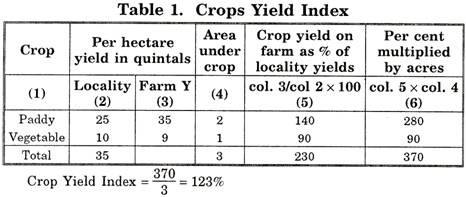The following points highlight the top four types of efficiency indicators related to agriculture.
They are: 1. Land or Production Efficiency 2. Labour Efficiency 3. Capital Efficiency 4. Farm Income or Profit Efficiency Indicators.
Type # 1. Land or Production Efficiency:
It is necessary to know whether land is efficiently used or not.
It can be known by studying following indicators:
ADVERTISEMENTS:
(i) Intensity of cropping:
This method measures the extent of the use of land for cropping purpose during a given year.
It is expressed as:
Cropping intensity = (Area cropped /Total cultivated area ) X 100
ADVERTISEMENTS:
More the cropping intensity better it is. When cropping intensity is 200 that means two crops are grown in a year.
(ii) Yield per hectare:
It is also a production efficiency indicator. If yield per hectare is more on a particular land that land is more efficient than low yielding land.
Average yield of locality is also taken into consideration as:
ADVERTISEMENTS:
Paddy yield per hectare of a firm is 35 q.
Average yield of locality is 25 q. per hectare.
Production efficiency of a farm ‘y’
(35 x 100)/25 = 140%
(iii) Crop yield index:
This index is work out for all crops for comparison of the yields of all crops on a given farm with the average yields of these crops in the locality.
Type # 2. Labour Efficiency:
Labour efficiency in farm business refers to the amount of productive work completed per man on the farm per unit of time. If labourers are efficient, farm business can be profitable one.
Efficiency of labour depends upon following things:
ADVERTISEMENTS:
(i) Physical condition of labour, healthy labour takes interest in his work he can do well otherwise there will be many errors in his work.
(ii) Climate condition under which he works.
Labour Efficiency Indicators are as follows:
(i) Return per family labour day:
ADVERTISEMENTS:
If return per family labour day is to be worked out, under mentioned formula can be used.
= Family labour income/Number of family labour days
(ii) Return per worker:
= Output minus cost of input factor other than human labour/Total number of workers
ADVERTISEMENTS:
(iii) In countries where labour is scarce factor, the efficiency of labour is judged by:
(a) Number of hectares of crop per labour.
(b) Number of cows per man or the amount of milk produced or sold per man.
(c) The number of egg laying hens per man.
(d) Number of hectares of fruit crop per man.
Increasing Labour Efficiency:
ADVERTISEMENTS:
For increasing labour efficiency output of the farm must be increased and for that following measures must be used as:
(i) Farm manager should look that all the tools and implements are in good condition few days before they required.
(ii) Farm manager should assign duties according to interest of the labourers.
(iii) Facilities for lunch, rest should be near to the spot of work.
(iv) Where trained labourers are required, training should be provided to labourers.
(v) Payment should be made according to skill, capacity to work, honesty length of continuous service of the labourer.
ADVERTISEMENTS:
(vi) Housing facilities, medical facility, educational facility to children of labourers, recreation facility should be given to labourers. This will help to increase the efficiency of labourers.
Type # 3. Capital Efficiency:
There are many indicators to know efficiency of capital.
They are:
1. Over head charges:
Over head charges implies to fixed costs such as depreciation, yearly insurance premium, interest on total investment, land revenue, water taxes and miscellaneous taxes etc.
Overhead charges ratio = Total fixed cost per year/Gross income
ADVERTISEMENTS:
This ratio can be reduced by increasing production. Smaller the ratio more efficient is the fixed capital use.
1. Operating ratio:
Operating ratio refers to operating expenses required for agriculture production. Operating ratio can be worked out for a year or separately for a season, so as to know in which season capital is efficiently used.
Total operating cost Operating ratio = Total operating cost/Total profit
If this ratio is smaller better it is or it means, the particular capital is efficiently used.
2. Capital per unit of gross income:
ADVERTISEMENTS:
The unit of gross income may be rupees hundred.
=Total capital invested Gross income/Gross income
Smaller ratio indicates efficient use of capital. Less capital is able to produce efficient income.
3. Rate of capital turn over:
This is not only used in agriculture but also used in industrial sector.
Rate of capital turn over = Gross income 100/Total farm assets
Faster turnover rate is a good sign of farm business.
Type # 4. Farm Income or Profit Efficiency Indicators:
There are several measures or indicators of farm income or profit.
Those are as follows:
(i) Net farm cash income:
Total cash receipts from production minus total cash operating expenses.
(ii) Net farm income:
Net cash income plus change in inventory.
(iii) Farm Earnings:
Net farm income plus value of farm produce used in home.
(iv) Family labour earnings:
Farm earnings minus interest charged on farm capital.
(v) Returns to management:
Family labour earnings minus imputed value of family labour.
